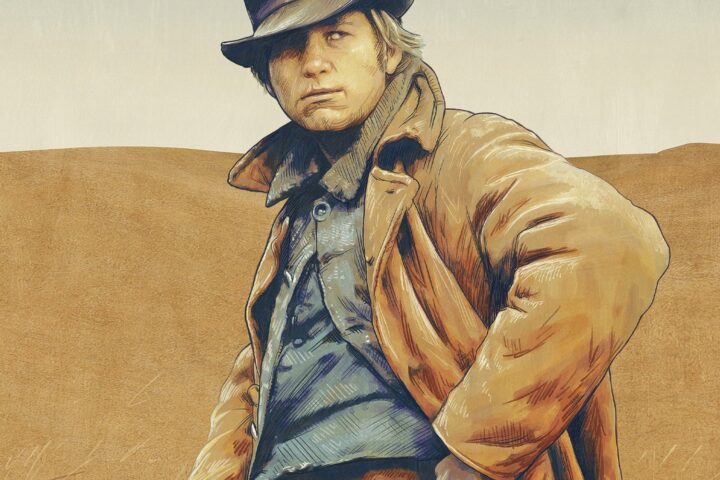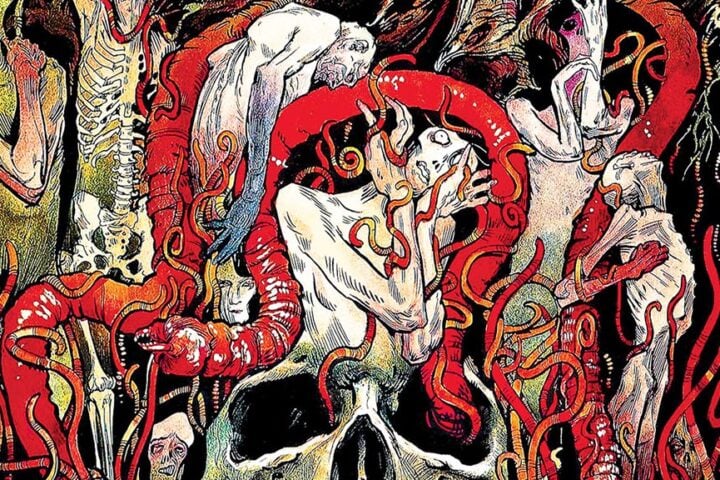The poster child of cinematic modernism, one of those early-‘60s event films that seemed to break every rule classical Hollywood ever codified, Alain Resnais’s Last Year at Marienbad left its initial audiences in equal measure ravished by Sacha Vierny’s sumptuous cinematography, capturing in rapturous detail every element of its chateau setting’s florid production design, and baffled by its deliberately disorienting puzzle-picture narrative, so willfully inscrutable that its three main characters don’t even have names. You have to trouble yourself to read Alain Robbe-Grillet’s screenplay in order to glean that they’re called A, X, and M, as if to emphasize that they’re variables in some erotic algorithm.
Unlike the testimonials to the politique des auteurs, all the rage with the Cahiers du Cinéma crowd, Last Year at Marienbad draws its power from a different engine, the disparate and ultimately divergent sensibilities of its director and screenwriter. Resnais, fresh off the critical success of Hiroshima Mon Amour, which interrogates the mixing of memory and desire in the lives of two lovers wounded by wartime experiences, plays up Last Year at Marienbad’s elegant theatricality, pitched somewhere between statuary and opera, as exemplified by the stilted rendition of Henrik Ibsen’s Rosmersholm that’s performed during the film’s opening scenes.
Robbe-Grillet enjoyed lavishing minute descriptions of almost geometric exactitude on details of architecture and décor, while hiding in plain sight intimations of sadomasochistic rape and murder like perverse Easter eggs in works with titles like The Voyeur, Jealousy, and In the Labyrinth—all of which, it must be said, would’ve made excellent alternate titles for this film. As Robbe-Grillet describes in his intro to the published script, Last Year at Marienbad is “an attempt to construct a purely mental space and time—those of dreams, perhaps, or of memory, those of any effective life—without excessive insistence on the traditional relations of cause and effect, nor on an absolute time sequence in narrative.” The film was shot, as it were, in the conditional mood, exploiting a narrative tense that hashes together future and past.
Such a philosophy of screenwriting brings to mind Jean-Luc Godard’s famous quip: “I agree a film should have a beginning, middle, and end. But not necessarily in that order.” Like variations on the game of Nim played throughout Last Year at Marienbad, the film invites the viewer to select and rearrange its constituent parts. Consequently, there’s no firm anchor by which audiences can establish any certainty, events take place in an indeterminate time frame, and it’s never clear whether they represent reality or fantasy, desire or fear, let alone whose.
In a palatial resort hotel, a man, X (Giorgio Albertazzi), approaches a woman, A (Delphine Seyrig), claiming they met a year ago, “perhaps” in Marienbad, and fell in love. The woman, under the watchful eye of M (Sacha Pitoëff), who may or may not be her husband, begged a year’s reprieve before running away with X. And so X has descended on her like a lovelorn Orpheus, to convince her to fulfill her promise. At first incredulous, A slowly comes to accept X’s version. At the same time, X’s persuasion steadily darkens into its obverse, compulsion.
The repetition-with-variation imagery suggests a moment of sexualized violence, but Resnais shoots what the script describes as a relatively overt rape scene with perverse circumspection; the camera rapidly dollies down a hallway, then turns a corner sharply, and enters a room, where A greets it with outstretched arms. Resnais repeats the scenario several times, going so far as to overexpose the film stock so that the image takes on a spectral quality. Moments from some lost expressionist screen test, these shots gauge the influence of silent cinema on Last Year at Marienbad’s acting and ambience, as does the flagrant lifting of Seyrig’s costume and coiffure inspired by Theda Bara and Louise Brooks, respectively. To illustrate precisely what he wanted, Resnais reportedly screened G.W. Pabst’s Pandora’s Box for his cast and crew.
About 11 minutes into Last Year at Marienbad, Alfred Hitchcock (or an elaborate full-sized cutout, at any rate) makes one of his trademark cameo appearances, perhaps the only one not in his own film. It’s easy to miss in the midst of all those mannequin-like patrons. Not just a debt of gratitude to one of Resnais’s favorite filmmakers, this nearly imperceptible jeu d’esprit illuminates his playful approach to mise-en-scène, and teases out the film’s generic pedigree.
Whatever else it may or may not be, Last Year at Marienbad is a mystery thriller, using the latter term perhaps a trifle loosely, that bears more than a few trappings of the horror genre. No coincidence, then, that one of the films most indebted to Last Year at Marienbad, Stanley Kubrick’s The Shining, borrows liberally at stylistic and thematic levels, engaging in similar-seeming Steadicam shots tracking ceaselessly along the Overlook’s pattern-carpeted hallways, and putting forward the uncanny suggestion that its terrible events have all happened before and likely will happen again, forever and ever and ever.
Image/Sound
Kino Lorber’s 2160p UHD presentation of Last Year at Marienbad looks simply ravishing, doing full justice to cinematographer Sacha Vierny’s sumptuous monochromatic images. Exquisite details of the baroque décor and Delphine Seyrig’s Chanel-designed costumes really stand out. Black levels are deep and uncrushed. Grain looks well-maintained. Audio comes in a Master Audio mono, and it excellently delivers the occasional sound effects like shattering glass, as well as Francis Seyrig’s pipe organ-haunted score.
Extras
Novelist and film historian Tim Lucas contributes another of his typically terrific commentary tracks, chockfull of details on the film’s production history, the careers of its cast and crew, and its connections with other films by Alain Resnais and Alain Robbe-Grillet. Lucas also provides a number of fascinating readings of the film’s labyrinthine narrative construction. In an on-camera interview, filmmaker Volker Schlöndorff discusses his apprenticeship with Louis Malle, getting the gig on Last Year at Marienbad, filming conditions, and the legacy of the film.
Schlöndorff also narrates a making-of documentary that features recently discovered Super 8 footage shot by actress Françoise Spira. It’s a fascinating glimpse of Resnais and company working on location. Film historian James Quandt takes an abecedarian approach to Last Year at Marienbad’s themes and visual tropes. Also on the disc is “Toute la mémoire du monde,” Resnais’s 1956 documentary short that showcases France’s Bibliothèque nationale in a series of exquisite tracking shots reminiscent of those he’d use later in Last Year at Marienbad.
Overall
Gorgeous and glacial, Last Year at Marienbad is a haunting study of memory, persuasion, and obsession that takes place in a lavish baroque labyrinth.
Since 2001, we've brought you uncompromising, candid takes on the world of film, music, television, video games, theater, and more. Independently owned and operated publications like Slant have been hit hard in recent years, but we’re committed to keeping our content free and accessible—meaning no paywalls or fees.
If you like what we do, please consider subscribing to our Patreon or making a donation.


